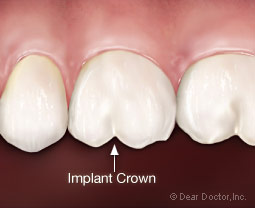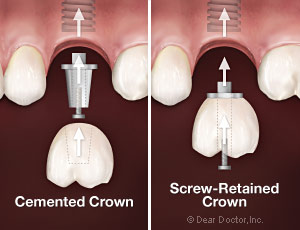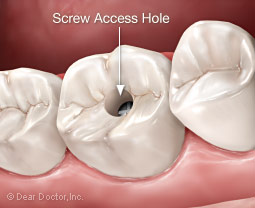How Crowns Attach to Dental Implants
Choosing between screws and dental cements
Dear Doctor,
I was intrigued to learn that implant crowns can either be screwed into implants or cemented on to them. Wouldn't a screwed-in crown look awful? Why would I want to have my crown attached this way?
 |
| Once a crown is attached to the implant, a person cannot determine which method of attachment was used (from the frontal view). |
Dear Jake,
I can understand your concerns; after all, you want your replacement tooth to function well, and look perfectly natural. Rest assured, you can have both with either a “screwed-in” or “cemented” implant crown.
While implants replace teeth, they are artificial and behave differently from natural teeth. A quick recap will be helpful in explaining why. A dental implant is a tooth-root replacement, to which an implant crown is attached. The crown is the only part you see in the mouth. The implant is placed surgically in the bone of the jaw to which it fuses in a process called osseo-integration (“osseo” – bone; “integrate” – to join or fuse). A great deal of thought, research and ingenuity has gone into dental implant tooth-replacement systems to make them as fail-safe as possible. Over and above what you see, there are many other clinical aspects and considerations involved in their design and functionality to protect and maintain implant survival.
 |
| Cemented Crown vs. Screw-Retained Crown
Click to enlarge |
Dental Implants — Dental Legos
Screws facilitate the attachment of the implant crowns to the implants. Implants must be strategically placed to allow implant crowns to connect to them, so that the crowns emerge through the gum tissues in exactly the right direction. An adjoining support structure called an “abutment” is often used to allow for this transition and connection.
Like Legos, implant components are designed to disassemble. Screw-retained implant crowns are more easily maintained; they allow for retention — keeping abutments and implant crowns in place, and retrievability — allowing the implant-crown components to be more easily removed, repaired or replaced, without damaging the implant or the restoration. While a successful dental implant can last a lifetime, most crowns do not. They may need to be replaced or repaired periodically, and this is much easier to do if they are attached with screws.
Loosening of the screw that attaches the restoration to the implant occasionally happens. Retightening or replacing the screw when the restoration is screw-retained is a simple and predictable procedure. This cannot be said for cemented restorations. Cemented crowns can be difficult to remove and, in the worst case, a screw access hole may have to be put in to remove the abutment and crown from the implant. Creating a screw access hole in the back teeth is not a cosmetic problem but for the front teeth, creating the screw access hole may affect the crown's appearance. It is difficult to know where the screw exit is located and often crowns removed in this fashion have to be remade. A weaker cement can be used to facilitate removal but this can lead to an insecurely attached crown falling off the abutment during use.
Aesthetic Considerations

People can object to screw-retained crowns believing that they may be unsightly — and in places, that might be true. That's why implant crowns are cemented to abutments whenever screws would show. Cemented restorations can accommodate more implant positions by covering abutment screw holes completely.
Screw-retained restorations can only be used in areas where the screw access holes are not so conspicuous, like the biting surfaces of back teeth. These access holes can be filled with composite tooth-colored filling material, rendering them essentially invisible to all but the dentist.
Keep in mind that cementation, too, can be problematic: Removal of excess cement, particularly if the implant-to-crown connection is deep within the tissues, can be difficult.
Screws Are Safer In Certain Situations
Immediately Loaded Implants
Screw-retained crowns are easier to manage when implants are crowned immediately. An implant is usually left in place for several months to fuse to the bone (osseo-integrate) before a crown is attached. But in some cases, the crown will be attached at the same time that the implant is placed — a process referred to as “immediate loading.” Here, screws offer additional advantages over cement. Sometimes the cement seal can be lost during the critical six-to-eight-week initial healing period or the cement can cause inflammation if it flows below the gum tissues.
Provisional Implant Crowns
To develop ideal aesthetics, a provisional (customized temporary) crown is required to shape and mold the soft gum tissues. The simplest method is to use a screw-retained provisional restoration. The screw can actually be used to “seat” the provisional crown and gently expand and accommodate the gum tissues.
Long-Term Treatment Planning
This topic is an extension of retrievability. Given the long-term survival characteristics of today's dental implants, they can outlast neighboring natural teeth that ultimately succumb to decay or periodontal disease. In these situations, the implants can often be used to support bridges if more natural teeth are lost. Sometimes even the substructures (the implants and abutments) of the existing implant crowns can be incorporated into the new bridgework. Screws play an important role in being able to retrieve and re-use existing implant restorations.
So as you can see, screwed-in crowns and cements have advantages and disadvantages. Your dentist will recommend which option is best for you.




